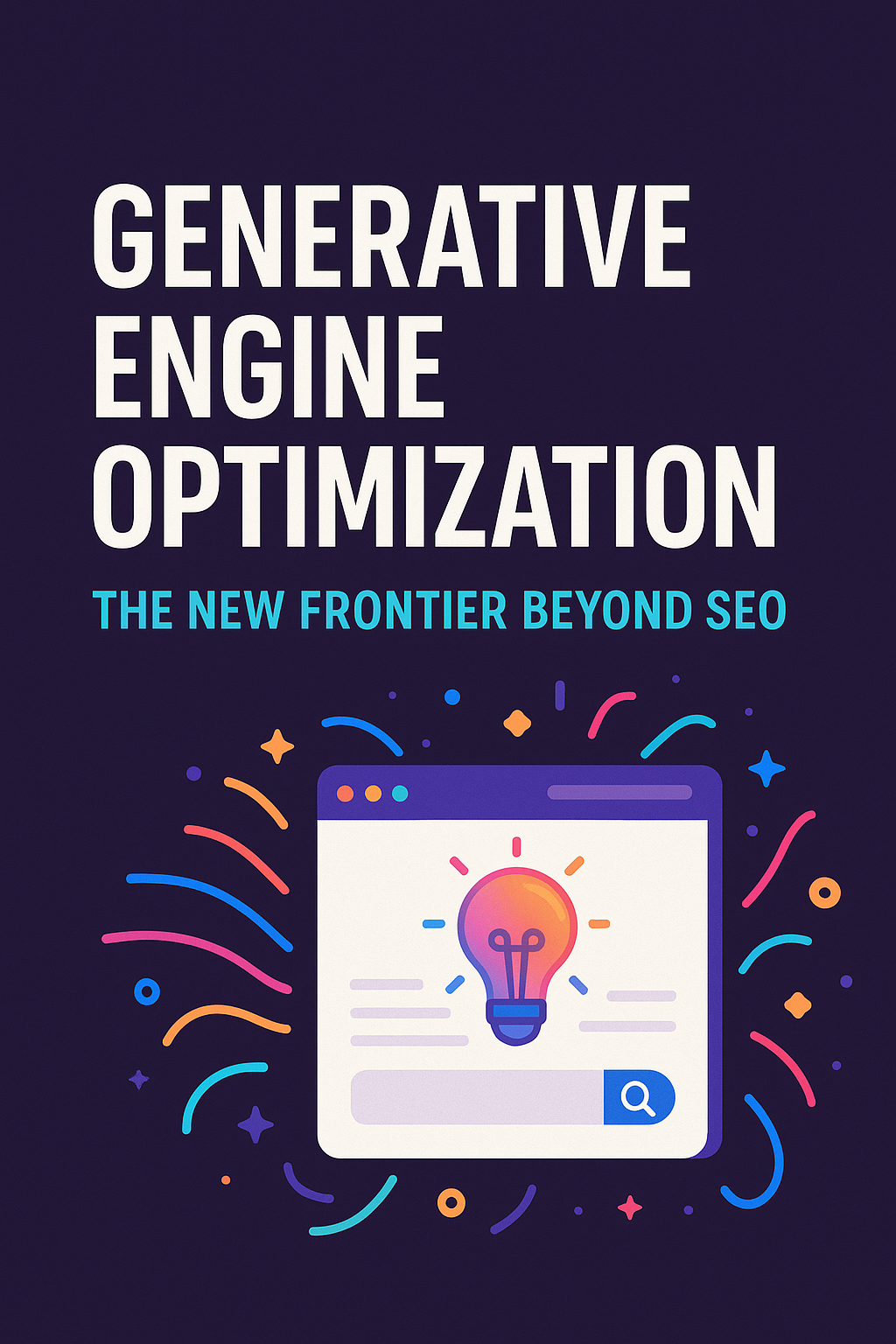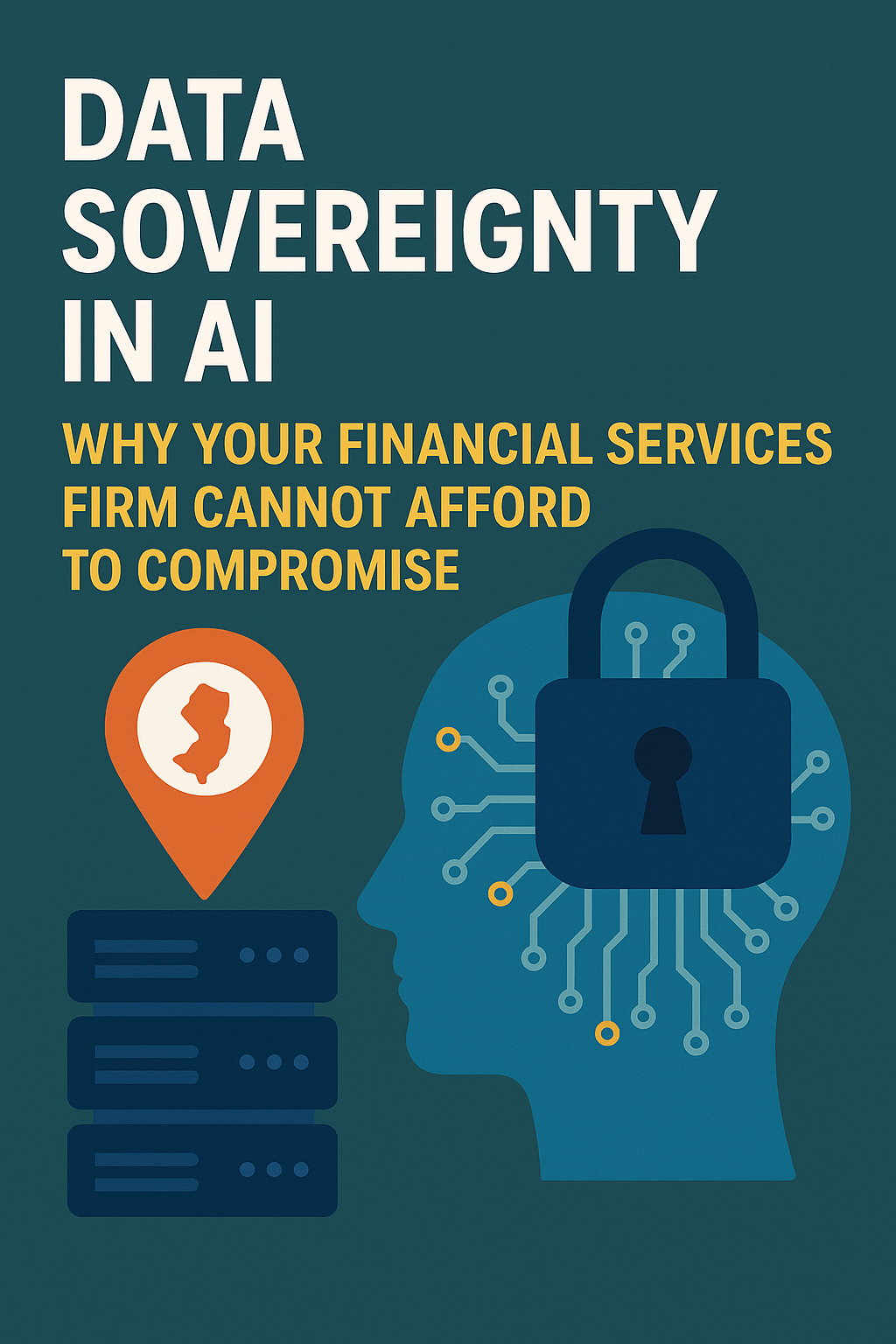
From Search Rankings to AI Citations: Your Roadmap to Digital Authority in 2025
The digital landscape is experiencing a seismic shift. While businesses have spent decades mastering Search Engine Optimization (SEO) to rank on Google, a new paradigm is emerging that's fundamentally changing how people discover information online. Welcome to the era of Generative Engine Optimization (GEO)—where the goal isn't just to rank in search results, but to be cited, referenced, and trusted by AI platforms like ChatGPT, Perplexity, Google's AI Overviews, and Claude.
If your business isn't preparing for this transformation, you're already falling behind.
What Is Generative Engine Optimization?
Generative Engine Optimization (GEO) is the practice of optimizing content to be referenced, cited, and featured within AI-generated responses from large language models (LLMs) and AI-powered search engines. Unlike traditional SEO, which focuses on ranking your website in a list of search results, GEO aims to make your content the authoritative source that AI platforms quote directly in their synthesized answers.
Think of it this way: SEO gets you on the list. GEO makes you the answer.
As of November 2025, AI-generated summaries appear in approximately 60% of Google search results, with projections indicating this will exceed 75% by 2028. This shift represents more than just a new feature—it's a fundamental reimagining of how information is discovered, consumed, and acted upon in the digital age.
The Rise of AI-Powered Search
The numbers tell a compelling story. ChatGPT now receives over 5.2 billion monthly visitors, making it one of the most-visited platforms on the internet. Perplexity AI has emerged as a serious contender in the search space, with users praising its citation-heavy approach and real-time web search capabilities. Google has integrated AI Overviews across its search platform, fundamentally changing how results are presented.
For businesses, this creates both a challenge and an opportunity. Research indicates that brands unprepared for AI search could experience a 20-50% decline in traffic from traditional search channels. Conversely, early adopters of GEO strategies are seeing unprecedented visibility in AI-generated responses, often appearing as the primary source cited across multiple platforms.
GEO vs. SEO: Understanding the Fundamental Differences
While GEO builds upon the foundation of traditional SEO, it introduces distinct objectives and strategies that every business leader must understand.
Different Goals, Different Metrics
Traditional SEO aims to achieve higher rankings in search engine results pages (SERPs), driving users to click through to your website. Success is measured in rankings, click-through rates, organic traffic, and conversions.
GEO focuses on being cited and referenced within AI-generated answers, often satisfying user intent without requiring a click to your website. Success is measured by citation frequency, AI visibility share, brand mentions in AI responses, and influence on decision-making before clicks occur.
Content Optimization Approaches
SEO Content Strategy:
- Keyword density and strategic placement
- Backlink building from authoritative sites
- Technical optimization (page speed, mobile-friendliness)
- Meta descriptions and title tags
- Internal linking structures
GEO Content Strategy:
- Conversational clarity and natural language
- Explicit entity recognition and associations
- Factual precision with authoritative references
- Structured content with clear hierarchies
- Citation-worthy formatting (statistics, expert quotes, data points)
- Multimodal content (text, images, videos)
The User Journey Transformation
Perhaps the most significant difference lies in how users interact with information. Traditional search presents multiple options, allowing users to choose which link to click. AI search provides a synthesized answer, often incorporating information from multiple sources into a single, coherent response.
This creates what industry experts call the "AI Dark Funnel"—the initial stages of the customer journey (awareness, research, comparison) now happen within AI conversations, where traditional web analytics cannot track interactions. GEO provides the methodology to influence this new, unmeasurable part of the funnel.
Why GEO Matters for Your Business in 2025
The shift to AI-powered search isn't a distant future scenario—it's happening now, and the implications for businesses are profound.
The Zero-Click Search Revolution
AI search is accelerating the trend toward "zero-click searches," where users get their answers directly from AI-generated summaries without visiting any website. While this might seem threatening to traditional web traffic models, it actually represents a powerful opportunity for brand visibility and authority building.
When your content is cited by ChatGPT, Perplexity, or Google's AI Overviews, you're not just getting a mention—you're being positioned as a trusted authority in your field. This top-of-funnel visibility influences decisions before users even consider clicking through to websites.
Demographic Shifts in Search Behavior
Millennials and Gen Z users are increasingly turning to AI platforms for search, with many preferring conversational AI interfaces over traditional search engines. These demographics represent not just current consumers but future decision-makers in business contexts. Companies that establish strong AI visibility now will benefit from compounding trust and recognition as these platforms become more dominant.
The Early-Mover Advantage
GEO is still relatively new, creating a significant opportunity for early adopters. Unlike SEO, where competition for top rankings is fierce and established players have decades of optimization, GEO represents a more level playing field. Brands that invest in GEO strategies now can establish themselves as authoritative sources before the space becomes saturated.
Proven Strategies for Generative Engine Optimization
Implementing an effective GEO strategy requires a multi-faceted approach that addresses both technical and content considerations.
1. Structure Content for AI Consumption
AI models excel at processing well-structured, clearly organized content. To optimize for AI consumption:
Lead with Direct Answers: Start sections with concise, complete answers to questions before diving into detailed explanations. This "BLUF" (Bottom Line Up Front) approach makes your content immediately useful to AI systems.
Use Natural Language Hierarchies: Implement proper heading structures (H1, H2, H3) that create logical content flows. Frame headings as natural questions that users might ask AI platforms.
Implement Structured Data: Schema markup (FAQ, HowTo, Article schemas) helps AI systems understand your content's purpose and context. This technical implementation significantly increases the likelihood of being cited in AI responses.
Create Scannable Formats: Use bullet points, numbered lists, tables, and summary boxes. AI models can easily extract and reference information presented in these formats.
2. Build Citation-Worthy Authority
AI platforms prioritize content from credible, authoritative sources. To strengthen your citation potential:
Include Compelling Data Points: Integrate specific statistics, research findings, and quantifiable information throughout your content. Aim for at least one data point every 150-200 words.
Cite Authoritative Sources: Link to credible external sources like peer-reviewed research, government data (.gov), educational institutions (.edu), and industry reports. This signals to AI that your content is well-researched and trustworthy.
Feature Expert Quotations: Include direct quotes from recognized experts with clear attributions. AI models favor content that demonstrates expertise through multiple authoritative voices.
Maintain Content Freshness: Regularly update content with new data, insights, and information. AI platforms strongly prefer current, up-to-date content, especially for rapidly evolving topics.
3. Optimize for Conversational Queries
AI search is inherently conversational, requiring content that aligns with natural language patterns:
Answer Questions Explicitly: Structure content around common questions in your industry. Use question-and-answer formats that directly address user intent.
Use Long-Tail, Conversational Keywords: Move beyond single keywords to full phrases and questions that mirror how people actually speak to AI assistants.
Provide Comprehensive Context: Don't assume prior knowledge. AI models need sufficient background information to confidently cite your content in their responses.
Anticipate Follow-Up Questions: Structure content to address not just the primary question but logical follow-up queries, creating comprehensive topic coverage.
4. Leverage Platform-Specific Strategies
Different AI platforms have distinct characteristics that require tailored approaches:
For ChatGPT:
- Focus on encyclopedic, comprehensive coverage
- Use authoritative, professional tone
- Create comparative content and detailed analyses
- Ensure brand mentions on high-authority sites likely in training data
For Perplexity AI:
- Prioritize content freshness and real-time relevance
- Implement strong source attribution throughout
- Use clear citation formats
- Create question-answer structured content
- Include multimedia elements (videos, infographics)
For Google AI Overviews:
- Maintain strong traditional SEO fundamentals
- Demonstrate E-E-A-T (Experience, Expertise, Authoritativeness, Trustworthiness)
- Implement comprehensive schema markup
- Align with Google's helpful content guidelines
5. Ensure Technical Accessibility for AI Crawlers
Your content must be technically accessible to AI systems:
Allow AI Crawler Access: Verify that your robots.txt file permits access to AI crawlers like GPTBot, Google-Extended, Claude-Web, and PerplexityBot.
Optimize for Fast Loading: AI crawlers favor sites with fast response times (under 200ms TTFB) and clean HTML.
Use Semantic HTML: Implement proper HTML5 elements that help AI understand content hierarchy and importance.
Avoid JavaScript Dependencies: Ensure critical content is accessible without JavaScript execution, as some AI crawlers may not process JavaScript.
Measuring GEO Success: New Metrics for a New Era
Traditional SEO metrics don't fully capture GEO performance. Businesses need to adopt new measurement approaches:
AI Visibility Metrics
Citation Frequency: Track how often your brand or content is referenced in AI-generated responses across different platforms.
Share of AI Voice: Measure the proportion of AI answers in which your brand appears, benchmarked against competitors.
Attribution Rate: Calculate the percentage of AI answers that explicitly cite your domain when using your content.
Sentiment and Context: Assess how your brand is portrayed within AI responses—not just frequency, but quality of mentions.
Monitoring Tools and Approaches
Several specialized tools have emerged to track GEO performance:
- LLM Monitoring Platforms: Tools like Otterly.ai and Surfer SEO's LLM Visibility Tools track citations across AI platforms
- Google Analytics 4 Regex Filters: Identify traffic from AI engines like Perplexity or Bing Copilot
- Direct Attribution Tracking: Include fields in lead forms asking how users discovered your brand
- Manual Prompt Testing: Regularly test relevant queries across AI platforms to monitor your visibility
The Integration Strategy: GEO + SEO
The most successful approach doesn't treat GEO and SEO as competing strategies but as complementary components of a comprehensive digital visibility strategy.
Shared Foundations
Both GEO and SEO benefit from:
- High-quality, well-researched content
- Clear content structure and logical flow
- Authoritative sources and credible information
- Regular content updates and maintenance
- Strong technical foundations
- User-focused content that satisfies intent
Dual Optimization Workflow
Implement a workflow that addresses both traditional search and AI search:
- Research Phase: Identify both traditional keywords and conversational queries/prompts
- Content Creation: Write for humans first, ensuring clarity and value
- SEO Optimization: Apply traditional SEO best practices (keywords, meta tags, backlinks)
- GEO Enhancement: Add AI-specific optimizations (structured data, citation formats, explicit answers)
- Technical Implementation: Ensure accessibility for both traditional crawlers and AI bots
- Measurement: Track both traditional SEO metrics and GEO-specific indicators
Common GEO Pitfalls to Avoid
As businesses rush to adopt GEO strategies, several common mistakes have emerged:
Over-Optimization for AI at the Expense of Humans: Content must remain valuable and readable for human audiences. AI-optimized content that's awkward or unnatural for humans will ultimately fail.
Neglecting Traditional SEO: GEO doesn't replace SEO—it complements it. Maintaining strong traditional SEO fundamentals remains essential.
Ignoring Platform Differences: Each AI platform has unique characteristics. A one-size-fits-all approach won't maximize visibility across all platforms.
Failing to Monitor and Adapt: The AI landscape evolves rapidly. Strategies that work today may need adjustment as AI models are retrained and updated.
Focusing Solely on Owned Content: AI platforms reference content from across the web, including third-party mentions, reviews, and discussions. A comprehensive GEO strategy must address your entire digital footprint.
The Future of Search: What's Next?
The evolution of AI-powered search is far from complete. Several trends will shape the next phase:
Machine Customers and Autonomous Agents
By 2028, an estimated 15% of workplace decisions will be handled by AI agents. These "machine customers" will research, evaluate, and even make purchasing decisions autonomously. Optimizing for these AI decision-makers will become as important as optimizing for human users.
Multimodal Search Expansion
AI search is expanding beyond text to incorporate images, videos, and voice. Content strategies must evolve to address these multimodal search experiences.
Increased Personalization
AI-generated answers will become increasingly personalized based on user preferences, history, and context. This creates both opportunities and challenges for maintaining consistent brand visibility.
Regulatory and Ethical Considerations
As AI search becomes more influential, expect increased scrutiny around algorithmic transparency, data usage, and ethical AI practices. Businesses must prepare for evolving regulatory frameworks.
Taking Action: Your GEO Implementation Roadmap
Ready to implement GEO in your organization? Follow this practical roadmap:
Phase 1: Assessment (Weeks 1-2)
- Audit current content for AI-friendliness
- Identify high-value topics and queries in your industry
- Benchmark current AI visibility across platforms
- Ensure technical accessibility for AI crawlers
Phase 2: Foundation Building (Weeks 3-6)
- Implement structured data across key content
- Optimize existing high-performing content for GEO
- Create citation-worthy content with data and expert quotes
- Establish monitoring systems for AI visibility
Phase 3: Expansion (Weeks 7-12)
- Develop platform-specific content strategies
- Build comprehensive topic coverage
- Strengthen authority signals and external mentions
- Refine based on performance data
Phase 4: Optimization (Ongoing)
- Continuously monitor AI visibility metrics
- Update content to maintain freshness
- Adapt to platform changes and algorithm updates
- Expand successful strategies across more topics
Conclusion: The Imperative of AI Visibility
Generative Engine Optimization isn't just another marketing buzzword—it's a fundamental shift in how information is discovered and consumed online. As AI-powered search continues to grow, businesses face a clear choice: adapt proactively or risk becoming invisible in the conversations where decisions are made.
The good news? The GEO landscape is still relatively new, creating significant opportunities for businesses that act now. By implementing the strategies outlined in this guide—structuring content for AI consumption, building citation-worthy authority, optimizing for conversational queries, and measuring AI-specific metrics—you can position your organization as a trusted source in the AI-powered future of search.
The question isn't whether AI search will transform digital visibility—it already has. The question is whether your business will be part of that transformation or left behind by it.
Start optimizing for generative engines today, and ensure your brand remains visible, relevant, and authoritative in the AI-powered future of search.
Frequently Asked Questions
What is the main difference between SEO and GEO?
SEO focuses on ranking websites in search engine results pages to drive clicks and traffic. GEO focuses on being cited and referenced within AI-generated answers, influencing users before they click on any website. SEO aims for visibility in a list of results; GEO aims to be the answer itself.
Which AI platforms should I optimize for?
The primary platforms for GEO optimization include ChatGPT (OpenAI), Perplexity AI, Google's AI Overviews and AI Mode, Claude (Anthropic), and Microsoft Copilot. Each platform has unique characteristics, so a comprehensive strategy should address multiple platforms with tailored approaches.
How long does it take to see results from GEO efforts?
GEO results typically appear faster than traditional SEO. Many businesses see initial AI citations within 2-4 weeks of implementing GEO optimizations, compared to 30-60 days for traditional SEO improvements. However, building sustained AI visibility requires ongoing effort and optimization.
Does GEO replace traditional SEO?
No, GEO complements rather than replaces SEO. Many GEO best practices build upon SEO fundamentals, and strong traditional SEO often improves GEO performance. The most effective strategy integrates both approaches to maximize visibility across traditional search and AI-powered platforms.
What type of content performs best for GEO?
Content that performs well for GEO typically includes: comprehensive, in-depth coverage of topics (2,000+ words); clear structure with question-based headings; specific data points and statistics; expert quotations with attribution; authoritative source citations; and regular updates to maintain freshness. Content should be conversational, well-structured, and citation-worthy.
How do I measure GEO success?
Key GEO metrics include citation frequency (how often AI platforms reference your content), share of AI voice (your visibility compared to competitors), attribution rate (percentage of AI answers that cite your domain), and sentiment/context of mentions. Specialized tools like Otterly.ai and Surfer SEO's LLM Visibility Tools can help track these metrics.
Can small businesses compete in GEO?
Yes! GEO represents a more level playing field than traditional SEO. Since the field is relatively new, small businesses that implement strong GEO strategies can compete effectively with larger competitors. Focus on creating authoritative, well-structured content in your niche, and you can achieve significant AI visibility regardless of company size.
About Vantage Point
Vantage Point specializes in AI-driven, tailored CRM solutions for financial services institutions. Our expertise in Salesforce Financial Services Cloud implementation and optimization empowers organizations to enhance client engagement, achieve operational excellence, and drive measurable business success. Contact us to learn how we can help your institution master personalization and transform your customer experience.
About the Author
David Cockrum founded Vantage Point after serving as Chief Operating Officer in the financial services industry. His unique blend of operational leadership and technology expertise has enabled Vantage Point's distinctive business-process-first implementation methodology, delivering successful transformations for 150+ financial services firms across 400+ engagements with a 4.71/5.0 client satisfaction rating and 95%+ client retention rate.
-
-
- Email: david@vantagepoint.io
- Phone: (469) 652-7923
- Website: vantagepoint.io
-



